Beneficial Microbes and Basal Fertilization in Antagonism of Banana Fusarium Wilt
Abstract
:1. Introduction
2. Materials and Methods
2.1. Materials
2.2. Antagonistic Assay in Culture Plate
2.3. Banana Cultivation and Irrigation Management
2.4. Banana Cultivation Management and Fertilizer Management
2.5. Fusarium Wilt Inoculation
2.6. Experimental Design of Field Test
2.7. Severity Level of the External Symptoms of Fusarium Wilt
2.8. Basic Nutrient Determination of Banana Leaf
2.9. Field Test of Benifical Microorgamisms and Basal Elements on Fusarium Wilt
2.10. Statistical Analysis
3. Results
3.1. TR4 Mycelium Inhibition Test
3.2. Field Trial on Banana Growth
3.2.1. Survival Rate
3.2.2. Banana Growth Height
3.2.3. Total Number of Banana Leaves
3.2.4. The Length and Width of the Banana Leaf
3.2.5. Yellow Ratio of Banana Leaves
3.2.6. Banana Leaf Symptom Severity Index
3.3. Nutrient Analysis of Banana Leaves
3.3.1. NPK of Banana Leaves
Nitrogen
Phosphate
Potassium
3.3.2. Analysis of Essential Metal Elements in Banana Leaves
Iron
Nickel
Copper
Zinc
3.3.3. Analysis of Nonessential Metal Elements in Banana Leaves
Chromium
Cadmium
Lead
4. Discussion
5. Conclusions
Supplementary Materials
Author Contributions
Funding
Data Availability Statement
Acknowledgments
Conflicts of Interest
References
- Ploetz, R.C. Fusarium Wilt of Banana Is Caused by Several Pathogens Referred to as Fusarium oxysporum f. sp. cubense. Phytopathology 2006, 96, 653–656. [Google Scholar] [CrossRef] [Green Version]
- Pegg, K.G.; Coates, L.M.; O’Neill, W.T.; Turner, D.W. The Epidemiology of Fusarium Wilt of Banana. Front. Plant Sci. 2019, 10, 1395. [Google Scholar] [CrossRef] [Green Version]
- Ploetz, R.C. Panama Disease: A Classic and Destructive Disease of Banana. Plant Health Prog. 2000, 1. [Google Scholar] [CrossRef] [Green Version]
- Hwang, S.-C.; Ko, W.-H. Cavendish Banana Cultivars Resistant to Fusarium Wilt Acquired through Somaclonal Variation in Taiwan. Plant Dis. 2004, 88, 580–588. [Google Scholar] [CrossRef] [Green Version]
- Dale, J.; James, A.; Paul, J.-Y.; Khanna, H.; Smith, M.; Peraza-Echeverria, S.; Garcia-Bastidas, F.; Kema, G.; Waterhouse, P.; Mengersen, K. Transgenic Cavendish bananas with resistance to Fusarium wilt tropical race 4. Nat. Commun. 2017, 8, 1496. [Google Scholar] [CrossRef] [PubMed] [Green Version]
- Wong, C.; Saidi, N.B.; Vadamalai, G.; Teh, C.Y.; Zulperi, D. Effect of bioformulations on the biocontrol efficacy, microbial viability and storage stability of a consortium of biocontrol agents against Fusarium wilt of banana. J. Appl. Microbiol. 2019, 127, 544–555. [Google Scholar] [CrossRef] [PubMed]
- Ho, Y.-N.; Chiang, H.-M.; Chao, C.-P.; Su, C.-C.; Hsu, H.-F.; Guo, C.-T.; Hsieh, J.-L.; Huang, C.-C. In planta biocontrol of soilborne Fusarium wilt of banana through a plant endophytic bacterium, Burkholderia cenocepacia 869T2. Plant Soil 2014, 387, 295–306. [Google Scholar] [CrossRef]
- Fu, L.; Penton, C.R.; Ruan, Y.; Shen, Z.; Xue, C.; Li, R.; Shen, Q. Inducing the rhizosphere microbiome by biofertilizer application to suppress banana Fusarium wilt disease. Soil Biol. Biochem. 2017, 104, 39–48. [Google Scholar] [CrossRef]
- Sun, J.; Zou, L.; Li, W.; Yang, J.; Wang, Y.; Xia, Q.; Peng, M. Rhizosphere soil properties and banana Fusarium wilt suppression influenced by combined chemical and organic fertilizations. Agric. Ecosyst. Environ. 2018, 254, 60–68. [Google Scholar] [CrossRef]
- Segura, M.R.A.; Stoorvogel, J.J.; Blanco, R.F.A.; Sandoval, F.J.A. A Medium-Term Field Experiment to Study the Effect of Managing Soil Chemical Properties on Fusarium Wilt in Banana (Musa AAA). J. Fungi 2021, 7, 261. [Google Scholar] [CrossRef]
- Dordas, C. Role of nutrients in controlling plant diseases in sustainable agriculture. A review. Agron. Sustain. Dev. 2008, 28, 33–46. [Google Scholar] [CrossRef] [Green Version]
- Yergeau, E.; Sommerville, D.W.; Maheux, E.; Vujanovic, V.; Hamel, C.; Whalen, J.K.; St-Arnaud, M. Relationships between Fusarium population structure, soil nutrient status and disease incidence in field-grown asparagus. FEMS Microbiol. Ecol. 2006, 58, 394–403. [Google Scholar] [CrossRef]
- Wu, X.; Shan, Y.; Li, Y.; Li, Q.; Wu, C. The soil nutrient environment determines the strategy by which Bacillus velezensis HN03 suppresses Fusarium wilt in banana plants. Front. Plant Sci. 2020, 11, 1801. [Google Scholar] [CrossRef] [PubMed]
- Hassan, M.A.; Abo-Elyousr, K.A. Impact of compost application on Fusarium wilt disease incidence and microelements contents of basil plants. Arch. Phytopathol. Plant Prot. 2013, 46, 1904–1918. [Google Scholar] [CrossRef]
- Hu, W.; Yang, B.; He, Z.; Li, G. Magnesium may be a key nutrient mechanism related to Fusarium wilt resistance: A new banana cultivar (Zhongjiao No. 9). PeerJ. 2021, 9, e11141. [Google Scholar] [CrossRef] [PubMed]
- Yi, Y.; Frenzel, E.; Spoelder, J.; Elzenga, J.T.M.; van Elsas, J.D.; Kuipers, O.P. Optimized fluorescent proteins for the rhizosphere-associated bacterium Bacillus mycoides with endophytic and biocontrol agent potential. Environ. Microbiol. Rep. 2017, 10, 57–74. [Google Scholar] [CrossRef] [PubMed] [Green Version]
- Jia, K.; Gao, Y.-H.; Huang, X.-Q.; Guo, R.-J.; Li, S.-D. Rhizosphere Inhibition of Cucumber Fusarium Wilt by Different Surfactinexcreting Strains of Bacillus subtilis. Plant Pathol. J. 2015, 31, 140–151. [Google Scholar] [CrossRef] [PubMed]
- Chen, Y.; Xu, Y.; Zhou, T.; Akkaya, M.S.; Wang, L.; Li, S.; Li, X. Biocontrol of Fusarium wilt disease in strawberries using bioorganic fertilizer fortified with Bacillus licheniformis X-1 and Bacillus methylotrophicus Z-1. 3 Biotech 2020, 10, 1–14. [Google Scholar] [CrossRef]
- Agarwal, M.; Dheeman, S.; Dubey, R.; Kumar, P.; Maheshwari, D.K.; Bajpai, V.K. Differential antagonistic responses of Bacillus pumilus MSUA3 against Rhizoctonia solani and Fusarium oxysporum causing fungal diseases in Fagopyrum esculentum Moench. Microbiol. Res. 2017, 205, 40–47. [Google Scholar] [CrossRef] [PubMed]
- Yuan, J.; Ruan, Y.; Wang, B.; Zhang, J.; Waseem, R.; Huang, Q.; Shen, Q. Plant Growth-Promoting Rhizobacteria Strain Bacillus amyloliquefaciens NJN-6-Enriched Bio-organic Fertilizer Suppressed Fusarium Wilt and Promoted the Growth of Banana Plants. J. Agric. Food Chem. 2013, 61, 3774–3780. [Google Scholar] [CrossRef] [PubMed]
- Liao, J.-H.; Chen, P.-Y.; Yang, Y.-L.; Kan, S.-C.; Hsieh, F.-C.; Liu, Y.-C. Clarification of the Antagonistic Effect of the Lipopeptides Produced by Bacillus amyloliquefaciens BPD1 against Pyricularia oryzae via In Situ MALDI-TOF IMS Analysis. Molecules 2016, 21, 1670. [Google Scholar] [CrossRef] [PubMed] [Green Version]
- Wu, J.-Y.; Liao, J.-H.; Shieh, C.-J.; Hsieh, F.-C.; Liu, Y.-C. Kinetic analysis on precursors for iturin A production from Bacillus amyloliquefaciens BPD1. J. Biosci. Bioeng. 2018, 126, 630–635. [Google Scholar] [CrossRef]
- Wu, J.J.; Huang, J.W.; Deng, W.L. Phenylacetic Acid and Methylphenyl Acetate From the Biocontrol Bacterium Bacillus mycoides BM02 Suppress Spore Germination in Fusarium oxysporum f. sp. lycopersici. Front Microbiol 2020, 11, 569263. [Google Scholar] [CrossRef]
- Peng, Y.-H.; Chou, Y.-J.; Liu, Y.-C.; Jen, J.-F.; Chung, K.-R.; Huang, J.-W. Inhibition of cucumber Pythium damping-off pathogen with zoosporicidal biosurfactants produced by Bacillus mycoides. J. Plant Dis. Prot. 2017, 124, 481–491. [Google Scholar] [CrossRef]
- Kuan, C.; Lin, M.; Wu, M.; Chen, H. Evaluation of banana cultivars resistance to Fusarium wilt disease. J. Taiwan Agric. Res. 2016, 65, 365–373. [Google Scholar]
- Getha, K.; Vikineswary, S. Antagonistic effects of Streptomyces violaceusniger strain G10 on Fusarium oxysporum f. sp. cubense race 4: Indirect evidence for the role of antibiosis in the antagonistic process. J. Ind. Microbiol. Biotechnol. 2002, 28, 303–310. [Google Scholar] [CrossRef] [PubMed]
- Carr, M.K.V. The water relations and irrigation requirements of banana (musa spp.). Exp. Agric. 2009, 45, 333–371. [Google Scholar] [CrossRef]
- Al-Harthi, K.; Al-Yahyai, R. Effect of NPK fertilizer on growth and yield of banana in Northern Oman. J. Hortic. For. 2009, 1, 160–167. [Google Scholar]
- Rispail, N.; Rubiales, D. Identification of sources of quantitative resistance to Fusarium oxysporum f. sp. medicaginis in Medicago truncatula. Plant Dis. 2014, 98, 667–673. [Google Scholar]
- Carlier, J.; De Waele, D.; Escalant, J.-V. Global Evaluation of Musa Germplasm for Resistance to Fusarium Wilt, Mycosphaerella Leaf Spot Diseases and Nematodes: In-Dept Evaluation; Printed by Arceaux 49; Bioversity International: Montpellier, France, 2002; Volume 6. [Google Scholar]
- AFS1120-1; AFS1110-1; AFS1130-1; AFS1105-1; AFS1293~9-1. Agriculture Fertilizer Standards; Agriculture and Food Agency of Council Agriculture Executive Yuan: Taipei, Taiwan, 2013.
- Du, N.; Shi, L.; Yuan, Y.; Sun, J.; Shu, S.; Guo, S. Isolation of a potential biocontrol agent Paenibacillus polymyxa NSY50 from vinegar waste compost and its induction of host defense responses against Fusarium wilt of cucumber. Microbiol. Res. 2017, 202, 1–10. [Google Scholar] [CrossRef] [PubMed]
- Lee, T.; Park, D.; Kim, K.; Lim, S.M.; Yu, N.H.; Kim, S.; Kim, H.-Y.; Jung, K.S.; Jang, J.Y.; Park, J.-C.; et al. Characterization of Bacillus amyloliquefaciens DA12 Showing Potent Antifungal Activity against Mycotoxigenic Fusarium Species. Plant Pathol. J. 2017, 33, 499–507. [Google Scholar] [CrossRef] [PubMed] [Green Version]
- Vitullo, D.; Di Pietro, A.; Romano, A.; Lanzotti, V.; Lima, G. Role of new bacterial surfactins in the antifungal interaction between Bacillus amyloliquefaciens and Fusarium oxysporum. Plant Pathol. 2011, 61, 689–699. [Google Scholar] [CrossRef]
- Abraham, A.; Narayanan, S.P.; Philip, S.; Nair, D.G.; Chandrasekharan, A.; Kochupurackal, J. In silico characterization of a novel β-1,3-glucanase gene from Bacillus amyloliquefaciens—A bacterial endophyte of Hevea brasiliensis antagonistic to Phytophthora meadii. J. Mol. Model. 2012, 19, 999–1007. [Google Scholar] [CrossRef] [PubMed]
- Bubici, G.; Kaushal, M.; Prigigallo, M.I.; Gómez-Lama Cabanás, C.; Mercado-Blanco, J. Biological control agents against Fusarium wilt of banana. Front. Microbiol. 2019, 10, 616. [Google Scholar] [CrossRef] [PubMed] [Green Version]
- Beibei, W.; Zongzhuan, S.; Zhang, F.; Waseem, R.; Jim, Y.; Huang, R.; Yunze, R.; Rong, L.; Qirong, S. Bacillus amyloliquefaciens strain W19 can promote growth and yield and suppress Fusarium wilt in banana under greenhouse and field conditions. Pedosphere 2016, 26, 733–744. [Google Scholar]
- Xiao, R.F.; Zhu, Y.-J.; Li, Y.-D.; Liu, B. Studies on Vascular Infection of Fusarium oxysporum f. sp. cubense Race 4 in Banana by Field Survey and Green Fluorescent Protein Reporter. Int. J. Phytopathol. 2013, 2, 44–51. [Google Scholar] [CrossRef]
- Xue, Q.-Y.; Chen, Y.; Li, S.-M.; Chen, L.-F.; Ding, G.-C.; Guo, D.-W.; Guo, J.-H. Evaluation of the strains of Acinetobacter and Enterobacter as potential biocontrol agents against Ralstonia wilt of tomato. Biol. Control 2009, 48, 252–258. [Google Scholar] [CrossRef]
- Qiu, M.; Zhang, R.; Xue, C.; Zhang, S.; Li, S.; Zhang, N.; Shen, Q. Application of bio-organic fertilizer can control Fusarium wilt of cucumber plants by regulating microbial community of rhizosphere soil. Biol. Fertil. Soils 2012, 48, 807–816. [Google Scholar] [CrossRef]
- Pugliese, M.; Liu, B.; Gullino, M.L.; Garibaldi, A. Microbial enrichment of compost with biological control agents to enhance suppressiveness to four soil-borne diseases in greenhouse. J. Plant Dis. Prot. 2011, 118, 45–50. [Google Scholar] [CrossRef]
- Saadi, I.; Laor, Y.; Medina, S.; Krassnovsky, A.; Raviv, M. Compost suppressiveness against Fusarium oxysporum was not reduced after one-year storage under various moisture and temperature conditions. Soil Biol. Biochem. 2010, 42, 626–634. [Google Scholar] [CrossRef]
- Shen, Z.; Zhong, S.; Wang, Y.; Wang, B.; Mei, X.; Li, R.; Ruan, Y.; Shen, Q. Induced soil microbial suppression of banana fusarium wilt disease using compost and biofertilizers to improve yield and quality. Eur. J. Soil Biol. 2013, 57, 1–8. [Google Scholar] [CrossRef]
- Cotxarrera, L.; Trillas-Gay, M.; Steinberg, C.; Alabouvette, C. Use of sewage sludge compost and Trichoderma asperellum isolates to suppress Fusarium wilt of tomato. Soil Biol. Biochem. 2002, 34, 467–476. [Google Scholar] [CrossRef]
- Bargabus, R.; Zidack, N.; Sherwood, J.; Jacobsen, B. Characterisation of systemic resistance in sugar beet elicited by a non-pathogenic, phyllosphere-colonizing Bacillus mycoides, biological control agent. Physiol. Mol. Plant Pathol. 2002, 61, 289–298. [Google Scholar] [CrossRef]
- Ha, M.T.; Huang, Y.-M.; Huang, J.-W. Influence of organic amendment and Bacillus subtilis on mineral nutrient uptake of asparagus bean in two field soils. Plant Pathol. Bull. 2008, 17, 289–296. [Google Scholar]
- Meena, V.S.; Maurya, B.; Meena, S.K.; Meena, R.K.; Kumar, A.; Verma, J.; Singh, N. Can Bacillus species enhance nutrient availability in agricultural soils? In Bacilli and Agrobiotechnology; Springer: London, UK, 2016; pp. 367–395. [Google Scholar]
- Yuan, J.; Zhang, N.; Huang, Q.; Raza, W.; Li, R.; Vivanco, J.M.; Shen, Q. Organic acids from root exudates of banana help root colonization of PGPR strain Bacillus amyloliquefaciens NJN-6. Sci. Rep. 2015, 5, srep13438. [Google Scholar] [CrossRef] [Green Version]
- Mia, A.B.; Shamsuddin, Z.H.; Wahab, Z.; Marziah, M. High-yielding and quality banana production through plant growth-promoting rhizobacterial (PGPR) inoculation. Fruits 2005, 60, 179–185. [Google Scholar] [CrossRef] [Green Version]
- Etesami, H.; Emami, S.; Alikhani, H.A. Potassium solubilizing bacteria (KSB): Mechanisms, promotion of plant growth, and future prospects. A review. J. Soil Sci. Plant Nutr. 2017, 17, 897–911. [Google Scholar] [CrossRef]
- Ambrosini, A.; Sant’Anna, F.H.; de Souza, R.; Tadra-Sfeir, M.; Faoro, H.; Alvarenga, S.M.; Pedrosa, F.O.; Souza, E.M.; Passaglia, L.M.P. Genome Sequence of Bacillus mycoides B38V, a Growth-Promoting Bacterium of Sunflower. Genome Announc. 2015, 3, e00245-15. [Google Scholar] [CrossRef] [PubMed] [Green Version]
- Yi, Y.; Kuipers, O.P. Development of an efficient electroporation method for rhizobacterial Bacillus mycoides strains. J. Microbiol. Methods 2017, 133, 82–86. [Google Scholar] [CrossRef] [PubMed]
- Yi, Y.; Li, Z.; Song, C.; Kuipers, O.P. Exploring plant-microbe interactions of the rhizobacteria Bacillus subtilis and Bacillus mycoides by use of the CRISPR-Cas9 system. Environ. Microbiol. 2018, 20, 4245–4260. [Google Scholar] [CrossRef] [PubMed] [Green Version]
- Hayat, R.; Ali, S.; Amara, U.; Khalid, R.; Ahmed, I. Soil beneficial bacteria and their role in plant growth promotion: A review. Ann. Microbiol. 2010, 60, 579–598. [Google Scholar] [CrossRef]
- Van Hoewyk, D.; Abdel-Ghany, S.E.; Cohu, C.M.; Herbert, S.K.; Kugrens, P.; Pilon, M.; Pilon-Smits, E.A.H. Chloroplast iron-sulfur cluster protein maturation requires the essential cysteine desulfurase CpNifS. Proc. Natl. Acad. Sci. USA 2007, 104, 5686–5691. [Google Scholar] [CrossRef] [PubMed] [Green Version]
- Eberhard, S.; Finazzi, G.; Wollman, F.-A. The Dynamics of Photosynthesis. Annu. Rev. Genet. 2008, 42, 463–515. [Google Scholar] [CrossRef] [PubMed] [Green Version]
- Adhikari, T.; Tel-Or, E.; Libal, Y.; Shenker, M. Effect of cadmium and iron on rice (Oryza sativa L.) plant in chelator-buffered nutrient solution. J. Plant Nutr. 2006, 29, 1919–1940. [Google Scholar] [CrossRef]
- Gao, L.; Chang, J.-D.; Chen, R.; Li, H.; Lu, H.; Tao, L.; Xiong, J. Comparison on cellular mechanisms of iron and cadmium accumulation in rice: Prospects for cultivating Fe-rich but Cd-free rice. Rice 2016, 9, 1–12. [Google Scholar] [CrossRef] [PubMed] [Green Version]
- Elazab, D.S.; Abdel-Wahab, D.A.; El-Mahdy, M.T. Iron and zinc supplies mitigate cadmium toxicity in micropropagated banana (Musa spp.). Plant Cell Tissue Organ Cult. 2021, 145, 367–377. [Google Scholar] [CrossRef]
- Robinson, J.C.; Saúco, V.G. Bananas and Plantains; Cabi: Wallingford, Oxfordshire, UK, 2010; Volume 19. [Google Scholar]
- Cabot, C.; Martos, S.; Llugany, M.; Gallego, B.; Tolrà, R.; Poschenrieder, C. A Role for Zinc in Plant Defense Against Pathogens and Herbivores. Front. Plant Sci. 2019, 10, 1171. [Google Scholar] [CrossRef] [PubMed]
- Einhardt, A.M.; Ferreira, S.; Hawerroth, C.; Valadares, S.; Rodrigues, F. Nickel potentiates soybean resistance against infection by Phakopsora pachyrhizi. Plant Pathol. 2020, 69, 849–859. [Google Scholar] [CrossRef]
- Gupta, V.; Jatav, P.K.; Verma, R.; Kothari, S.L.; Kachhwaha, S. Nickel accumulation and its effect on growth, physiological and biochemical parameters in millets and oats. Environ. Sci. Pollut. Res. 2017, 24, 23915–23925. [Google Scholar] [CrossRef]
- Siqueira Freitas, D.; Wurr Rodak, B.; Rodrigues dos Reis, A.; de Barros Reis, F.; Soares de Carvalho, T.; Schulze, J.; Carbone Carneiro, M.A.; Guimaraes Guilherme, L.R. Hidden nickel deficiency? Nickel fertilization via soil improves nitrogen metabolism and grain yield in soybean genotypes. Front. Plant Sci. 2018, 9, 614. [Google Scholar] [CrossRef] [Green Version]
- Ahmed, A.I.; Yadav, D.R.; Lee, Y.S. Applications of nickel nanoparticles for control of Fusarium wilt on lettuce and tomato. Int. J. Innov. Res. Sci. Eng. Technol. 2016, 5, 7378–7385. [Google Scholar] [CrossRef]
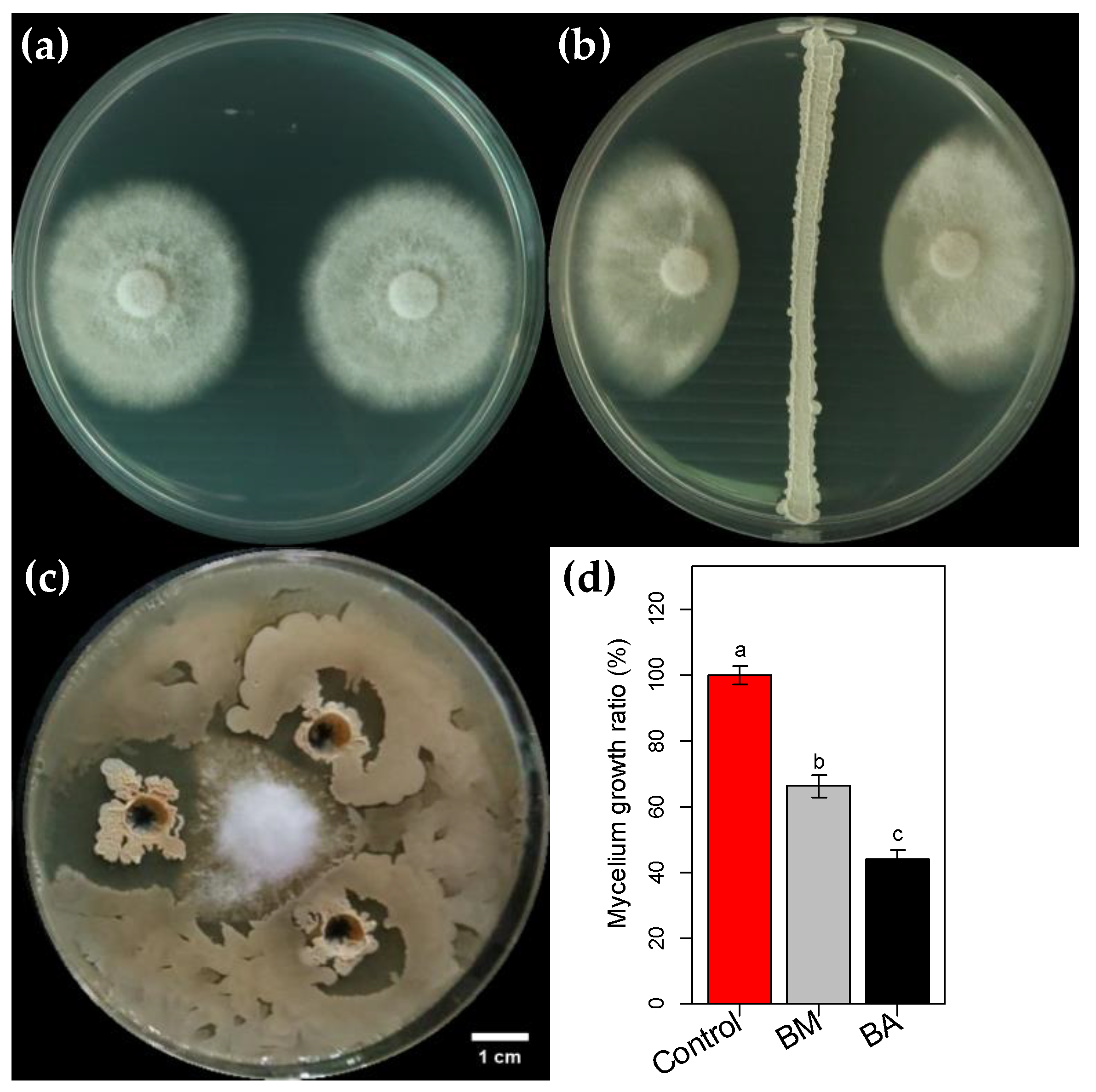

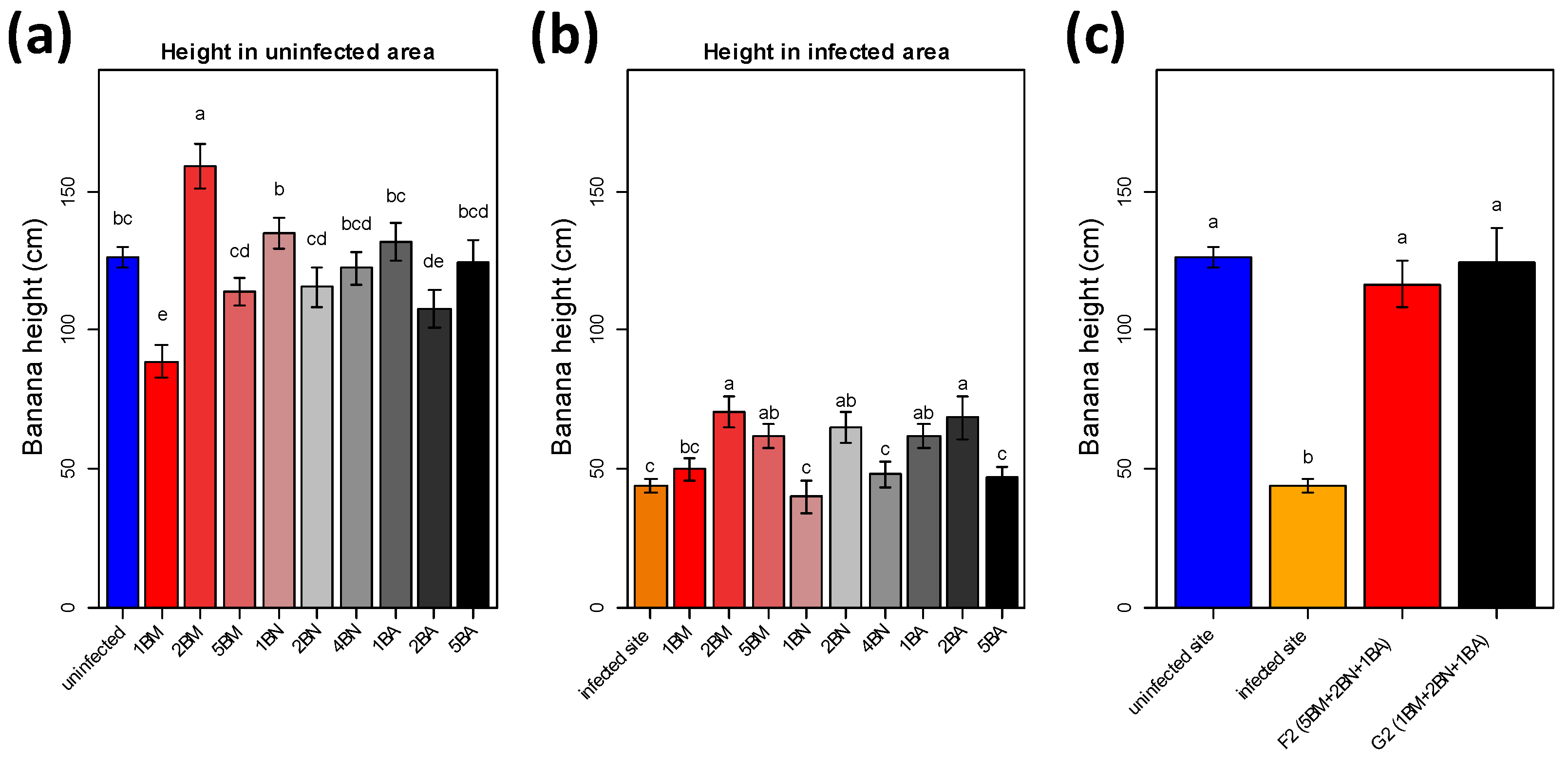
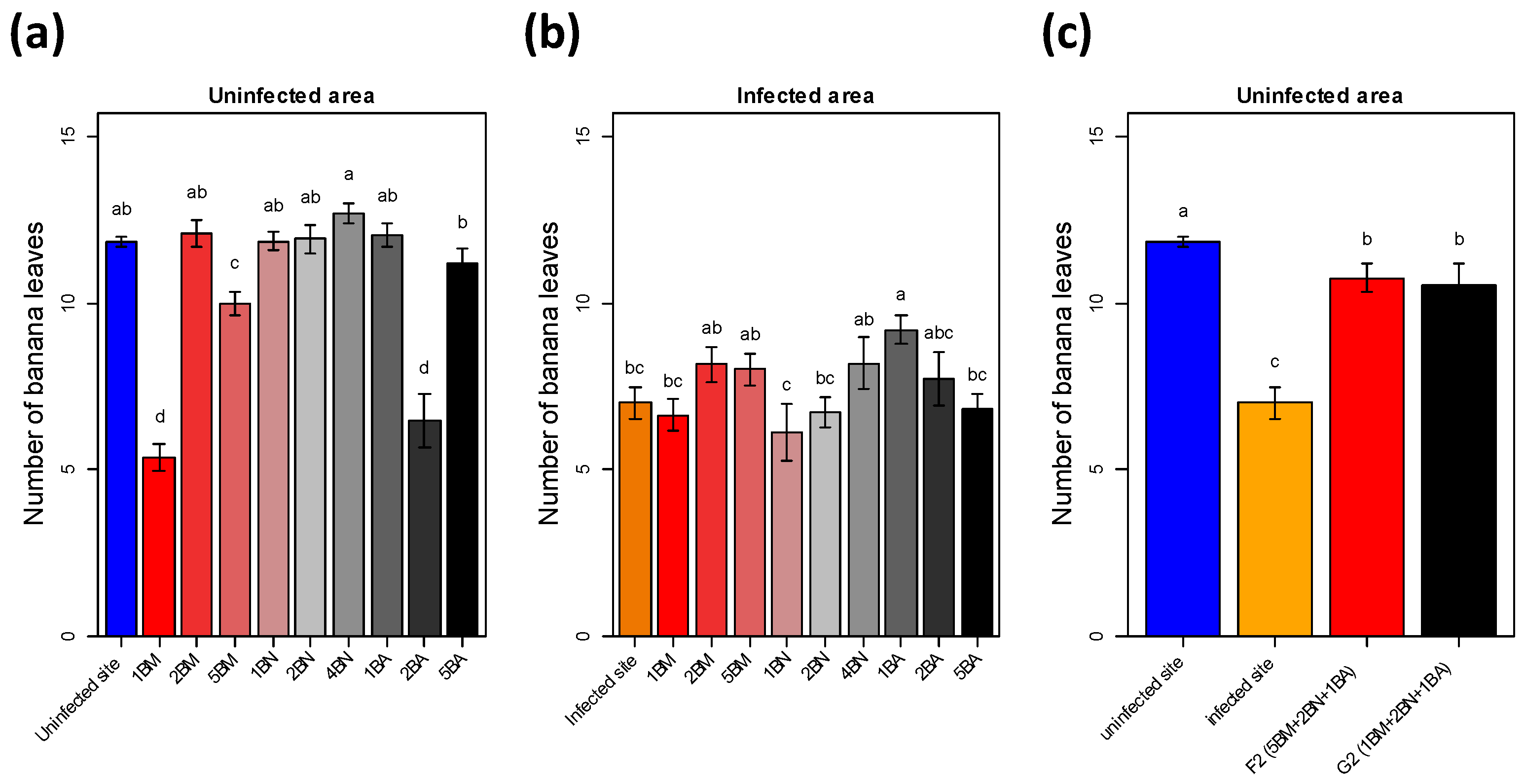
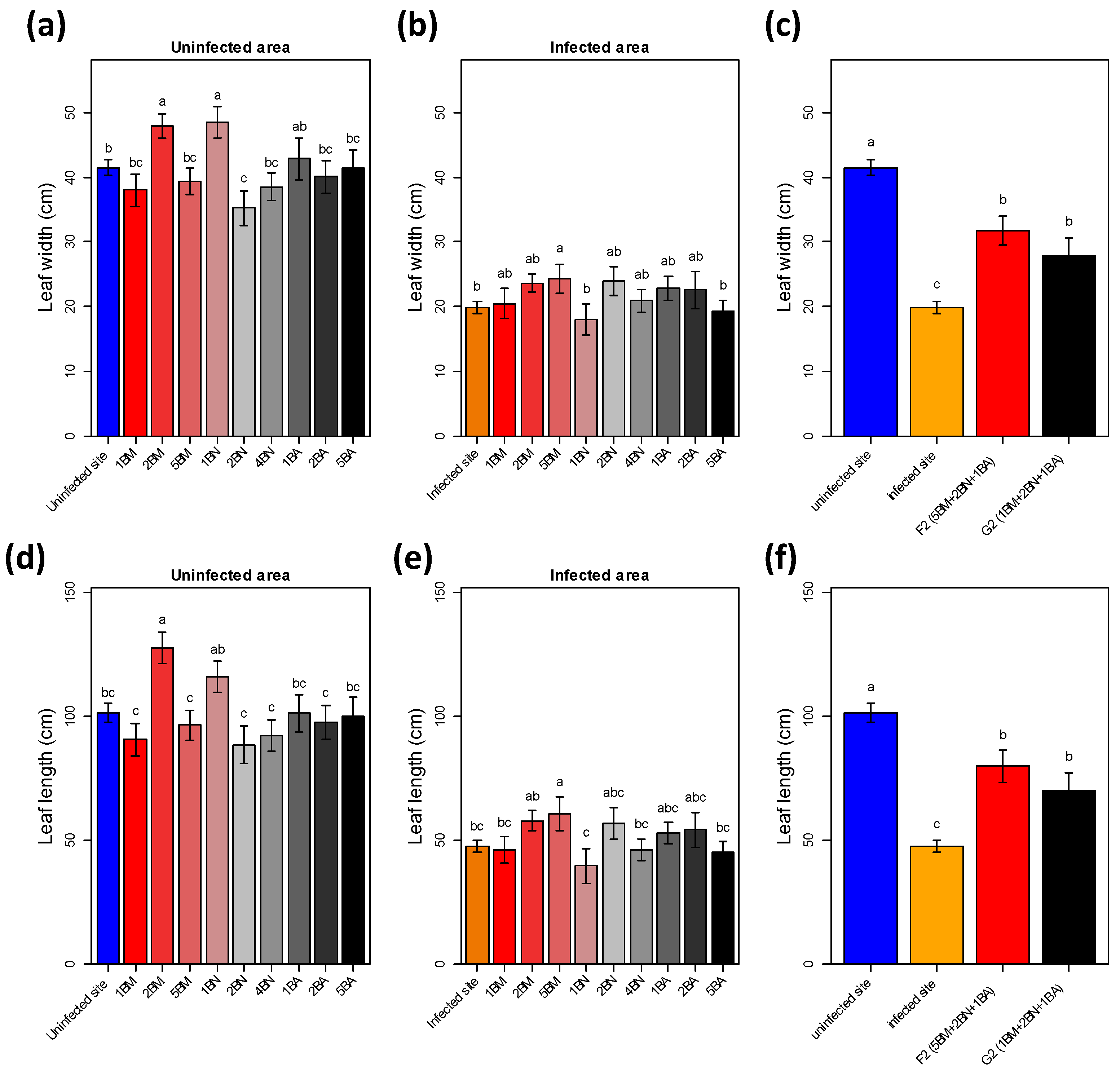
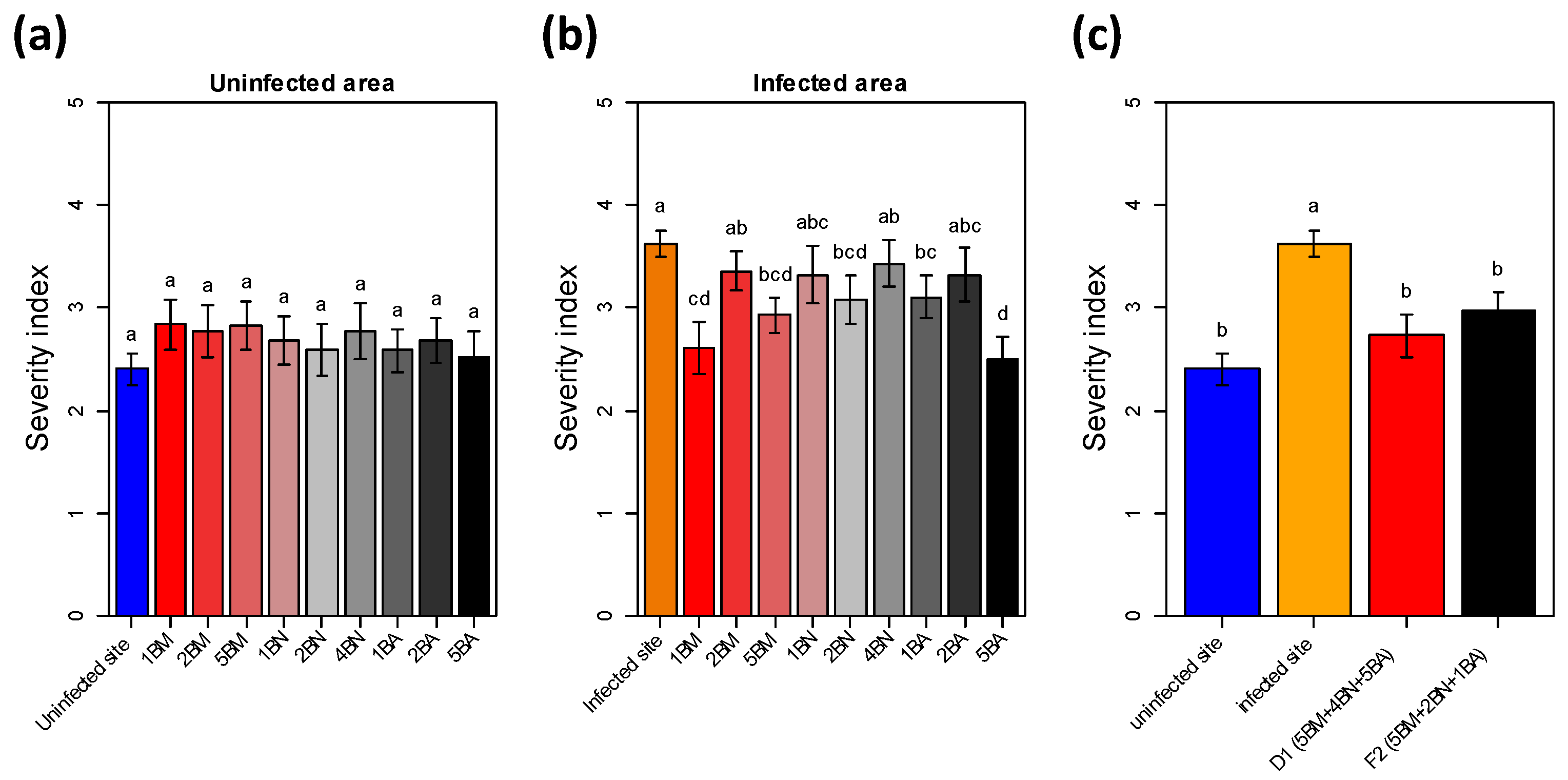
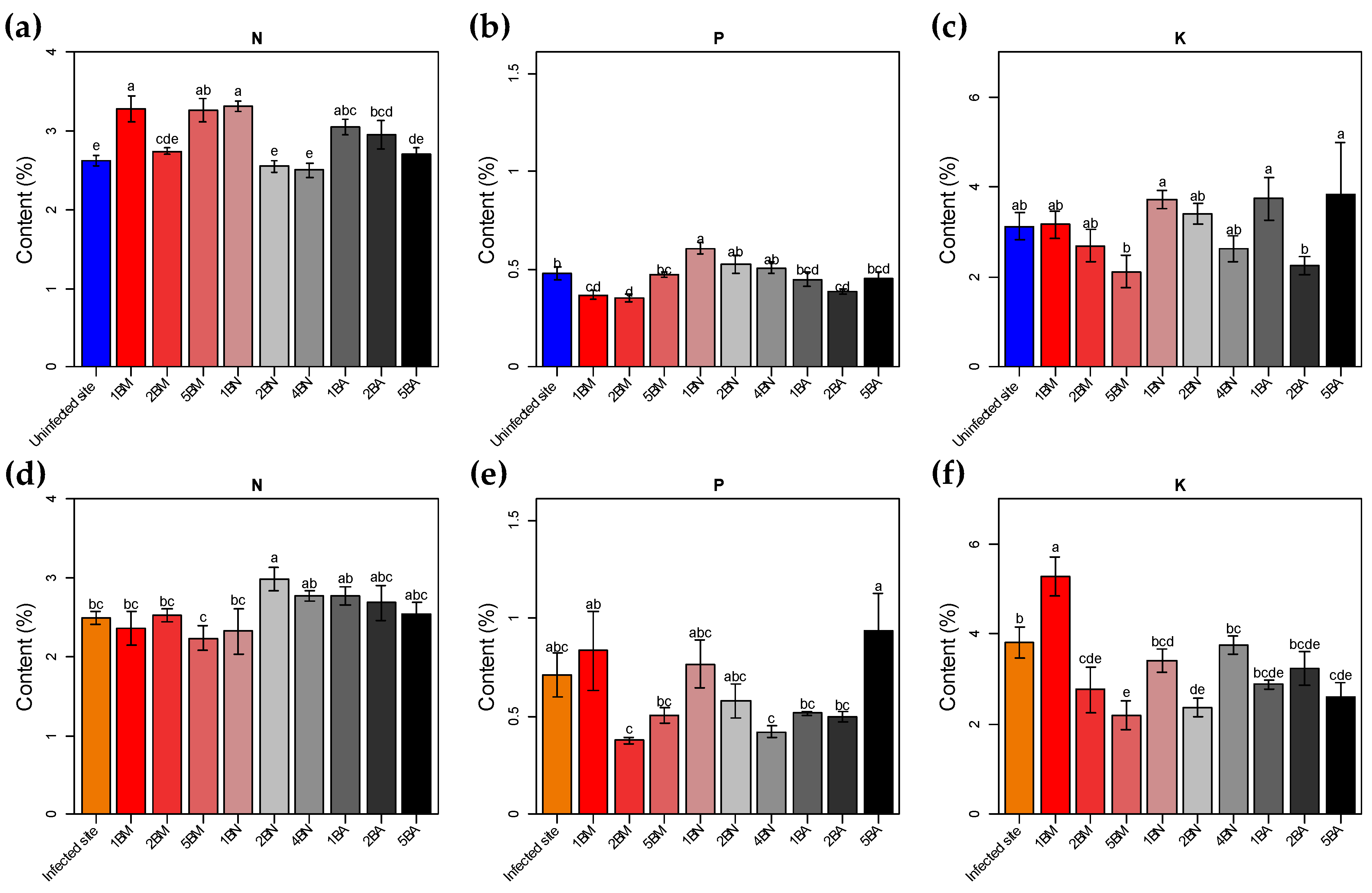
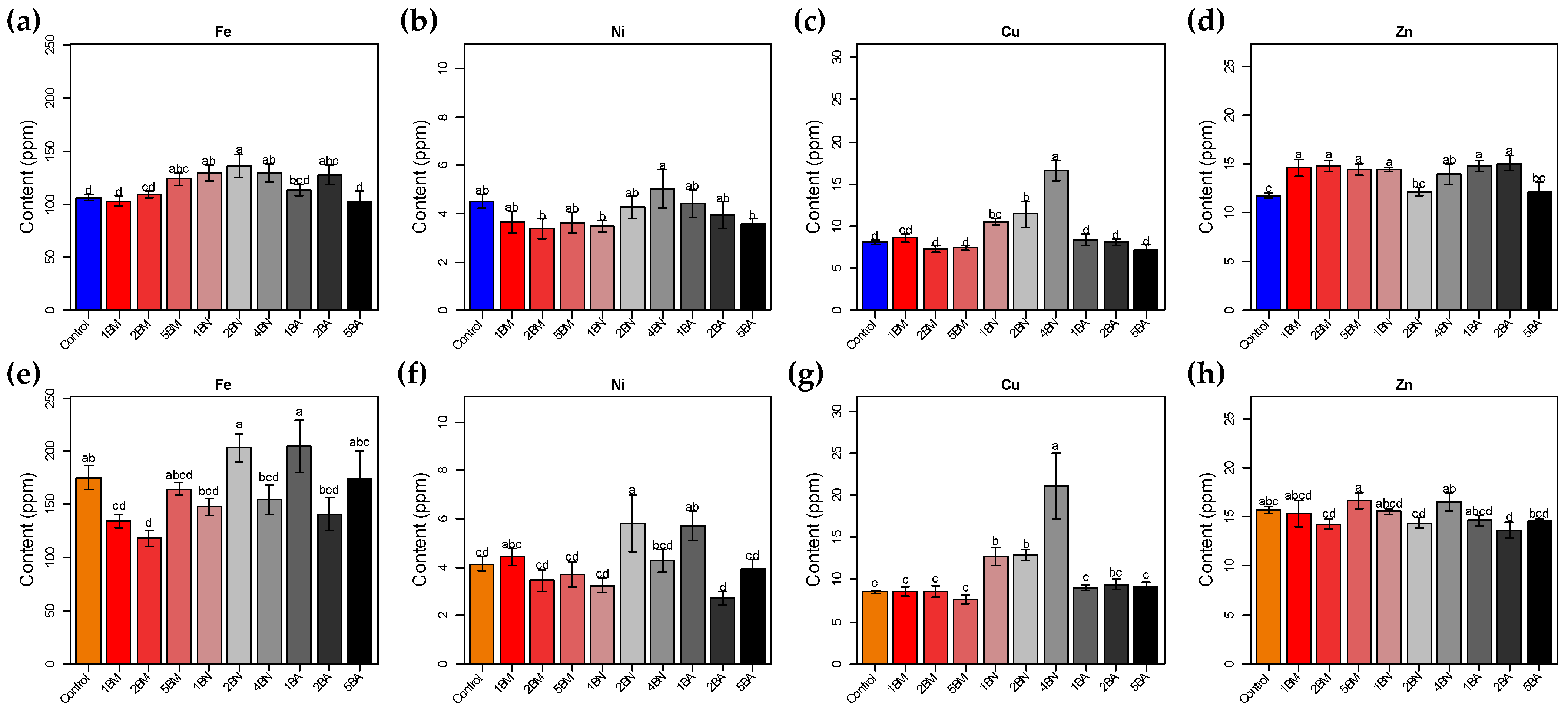
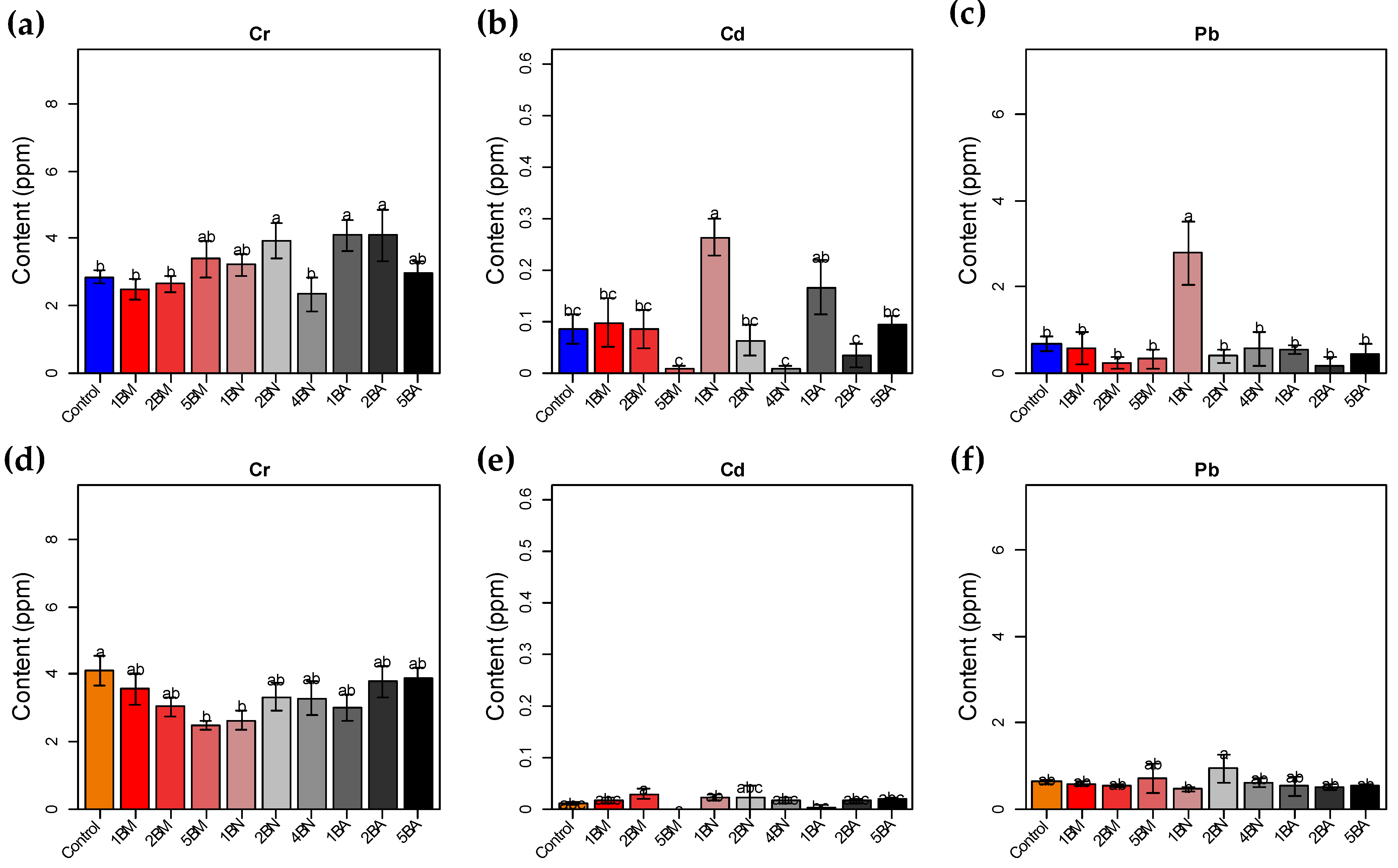
| Nitrogen (%) | Phosphate (%) | Potassium (%) | |
|---|---|---|---|
| Uninfected area | 2.9 ± 0.1 *** | 0.45 ± 0.01 | 3.07 ± 0.16 * |
| Infected area | 2.4 ± 0.1 | 0.50 ± 0.02 | 2.6 ± 0.11 |
| Fe (ppm) | Ni (ppm) | Cu (ppm) | Zn (ppm) | |
|---|---|---|---|---|
| Uninfected area | 118.2 ± 2.7 | 4.0 ± 0.2 | 9.4 ± 0.4 | 13.8 ± 0.3 |
| Infected area | 149.6 ± 3.7 *** | 4.2 ± 0.1 | 14.1 ± 0.7 *** | 16.1 ± 0.4 *** |
| Cr (ppm) | Cd (ppm) | Pb (ppm) | |
|---|---|---|---|
| Uninfected area | 3.21 ± 0.16 | 0.09 ± 0.01 *** | 0.67 ± 0.14 |
| Infected area | 3.58 ± 0.14 | 0.04 ± 0.01 | 0.63 ± 0.03 |
Publisher’s Note: MDPI stays neutral with regard to jurisdictional claims in published maps and institutional affiliations. |
© 2021 by the authors. Licensee MDPI, Basel, Switzerland. This article is an open access article distributed under the terms and conditions of the Creative Commons Attribution (CC BY) license (https://creativecommons.org/licenses/by/4.0/).
Share and Cite
Lin, C.-P.; Ho, Y.-C. Beneficial Microbes and Basal Fertilization in Antagonism of Banana Fusarium Wilt. Agronomy 2021, 11, 2043. https://doi.org/10.3390/agronomy11102043
Lin C-P, Ho Y-C. Beneficial Microbes and Basal Fertilization in Antagonism of Banana Fusarium Wilt. Agronomy. 2021; 11(10):2043. https://doi.org/10.3390/agronomy11102043
Chicago/Turabian StyleLin, Chung-Pao, and Yi-Cheng Ho. 2021. "Beneficial Microbes and Basal Fertilization in Antagonism of Banana Fusarium Wilt" Agronomy 11, no. 10: 2043. https://doi.org/10.3390/agronomy11102043





